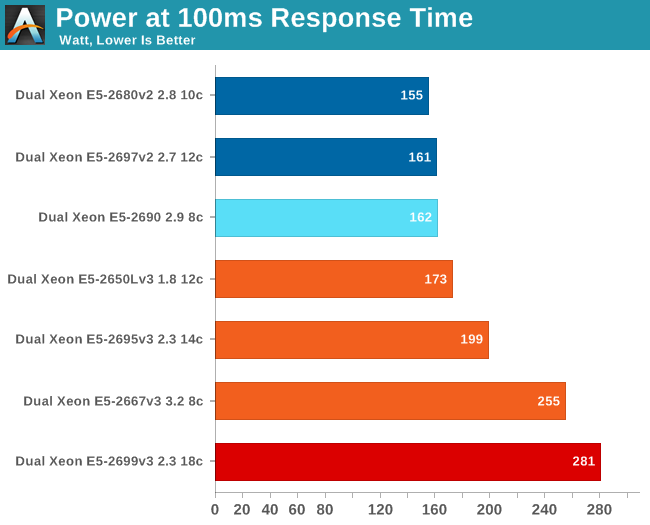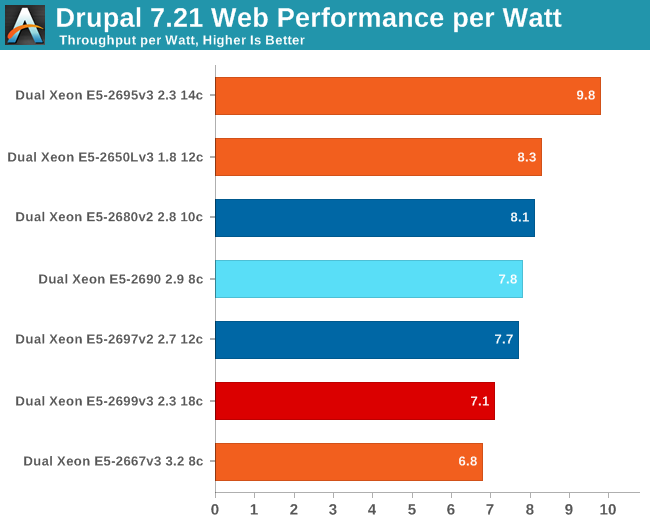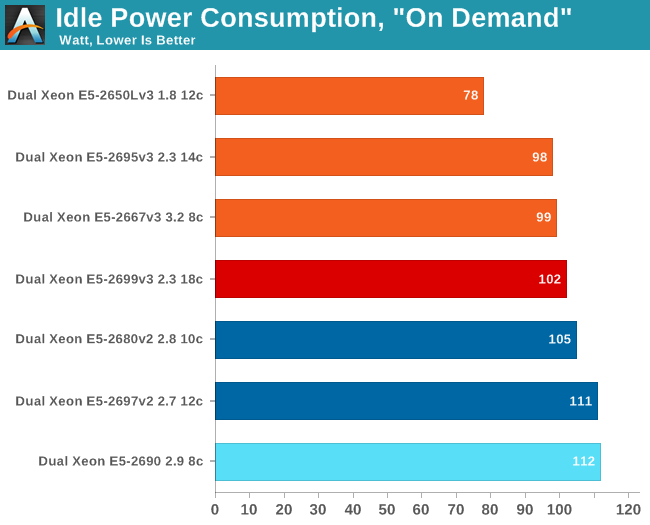Intel Xeon E5 Version 3: Up to 18 Haswell EP Cores
by Johan De Gelas on September 8, 2014 12:30 PM ESTDrupal Website: Performance per Watt
When we reviewed the Xeon E5-2600 v2, a performance per watt comparison was much more straightforward. Now we are faced with two different 2U-servers, with many similarities but also with some noteworthy differences. For example, the E5-2600 v3 based server is outfitted with six fans that can pull 1.6A, while our Xeon E5-2600 v2/v1 based server is outfitted with three fans that can pull 0.6A. If all fans are at their maximum RPM, the fans of the first server could easily pull 90W more. Also, our "Wildcat Pass" server still has to mature a bit as we are using a beta BIOS that has quite a few issues. Still, at idle, both servers are in the same ballpark.
The Haswell-EP reveals its mobile roots. The Idle power of the Xeon E5-2699 v3 is lower despite being a much larger chip than the Xeon E5-2697 v2, while both are baked upon the same process technology.
Next we measure the power consumed while keeping the response time at 100 ms. These are averages measured over a period of time. So basically we are measuring energy consumption, but we report the average power that was consumed over the same period of time.

It would be wrong to simply compare the numbers above as the Xeon E5-2695 and 2699 do considerably more work. However, it cannot be denied that the Xeon E5-2699 v3 and Xeon E5-2667 v3 are a lot more power hungry than the rest of the pack. Remember also that, as noted above, the fans of the server that hosted the Xeon E5 v3 consume quite a bit more, but at the moment we have not been able to determine how much.
Let's calculate performance per watt. Take the following graph with a grain of salt as the benchmark is not the most accurate (results tend to vary by 5-8%), but still it gives a rough idea of what you can expect.

The Xeon E5-2695 v3 is able to Turbo Boost to high clock speeds, which keeps the response time low. At the same time, the power consumption is limited. The Xeon E5-2699 v3 probably fires up the fans a lot higher, and that drives power consumption up as the fans in our server can consume quite a bit.
What this means is that TDP is once again a relatively decent predictor of actual power consumption. The lower TDP of the Xeon E5-2695 v3 (120w) materializes in real world power savings compared to the Xeon E5-2667 v3 (135W TDP) and Xeon E5-2699 v3 (145W TDP).











85 Comments
View All Comments
martinpw - Monday, September 8, 2014 - link
There is a nice tool called i7z (can google it). You need to run it as root to get the live CPU clock display.kepstin - Monday, September 8, 2014 - link
Most Linux distributions provide a tool called "turbostat" which prints statistical summaries of real clock speeds and c state usage on Intel cpus.kepstin - Monday, September 8, 2014 - link
Note that if turbostat is missing or too old (doesn't support your cpu), you can build it yourself pretty quick - grab the latest linux kernel source, cd to tools/power/x86/turbostat, and type 'make'. It'll build the tool in the current directory.julianb - Monday, September 8, 2014 - link
Finally the e5-xxx v3s have arrived. I too can't wait for the Cinebench and 3DS Max benchmark results.Any idea if now that they are out the e5-xxxx v2s will drop down in price?
Or Intel doesn't do that...
MrSpadge - Tuesday, September 9, 2014 - link
Correct, Intel does not really lower prices of older CPUs. They just gradually phase out.tromp - Monday, September 8, 2014 - link
As an additional test of the latency of the DRAM subsystem, could you please run the "make speedup" scaling benchmark of my Cuckoo Cycle proof-of-work system at https://github.com/tromp/cuckoo ?That will show if 72 threads (2 cpus with 18 hyperthreaded cores) suffice to saturate the DRAM subsystem with random accesses.
-John
Hulk - Monday, September 8, 2014 - link
I know this is not the workload these parts are designed for, but just for kicks I'd love to see some media encoding/video editing apps tested. Just to see what this thing can do with a well coded mainstream application. Or to see where the apps fades out core-wise.Assimilator87 - Monday, September 8, 2014 - link
Someone benchmark F@H bigadv on these, stat!iwod - Tuesday, September 9, 2014 - link
I am looking forward to 16 Core Native Die, 14nm Broadwell Next year, and DDR4 is matured with much better pricing.Brutalizer - Tuesday, September 9, 2014 - link
Yawn, the new upcoming SPARC M7 cpu has 32 cores. SPARC has had 16 cores for ages. Since some generations back, the SPARC cores are able to dedicate all resources to one thread if need be. This way the SPARC core can have one very strong thread, or massive throughput (many threads). The SPARC M7 cpu is 10 billion transistors:http://www.enterprisetech.com/2014/08/13/oracle-cr...
and it will be 3-4x faster than the current SPARC M6 (12 cores, 96 threads) which holds several world records today. The largest SPARC M7 server will have 32-sockets, 1024 cores, 64TB RAM and 8.192 threads. One SPARC M7 cpu will be as fast as an entire Sunfire 25K. :)
The largest Xeon E5 server will top out at 4-sockets probably. I think the Xeon E7 cpus top out at 8-socket servers. So, if you need massive RAM (more than 10TB) and massive performance, you need to venture into Unix server territory, such as SPARC or POWER. Only they have 32-socket servers capable of reaching the highest performance.
Of course, the SGI Altix/UV2000 servers have 10.000s of cores and 100TBs of RAM, but they are clusters, like a tiny supercomputer. Only doing HPC number crunching workloads. You will never find these large Linux clusters run SAP Enterprise workloads, there are no such SAP benchmarks, because clusters suck at non HPC workloads.
-Clusters are typically serving one user who picks which workload to run for the next days. All SGI benchmarks are HPC, not a single Enterprise benchmark exist for instance SAP or other Enterprise systems. They serve one user.
-Large SMP servers with as many as 32 sockets (or even 64-sockets!!!) are typically serving thousands of users, running Enterprise business workloads, such as SAP. They serve thousands of users.